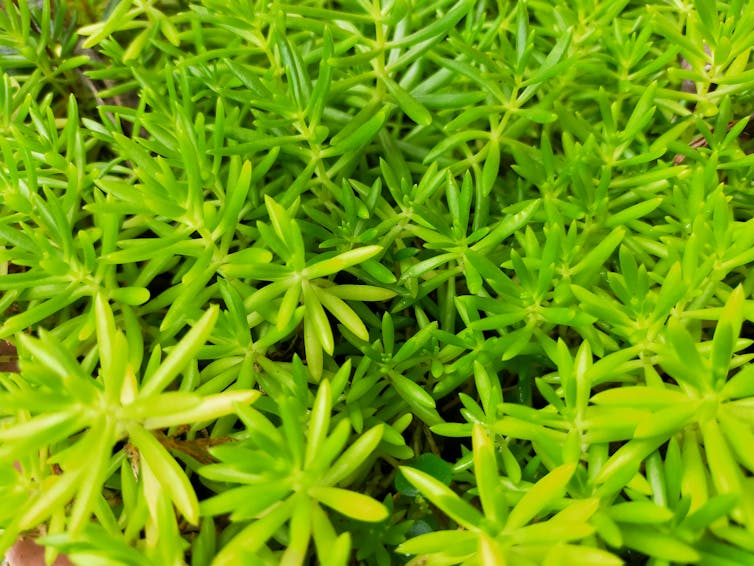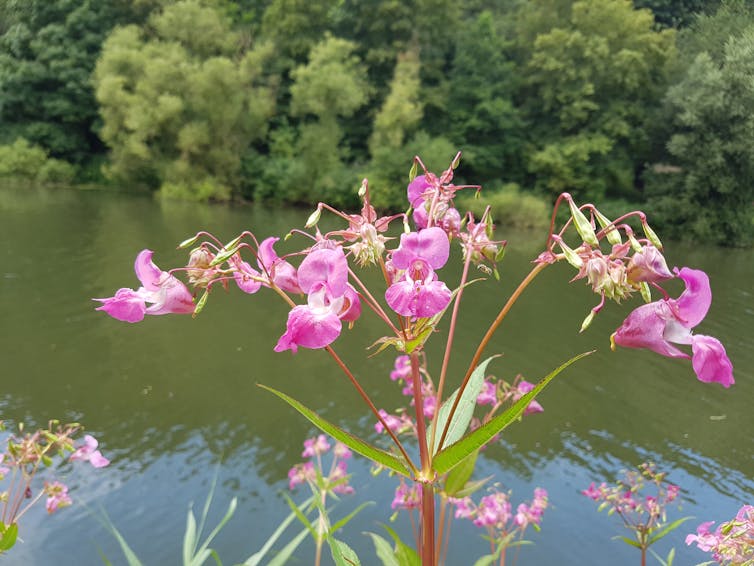Visitors to the Lake District have been unwittingly spreading invasive plants, including New Zealand pigmyweed, from lake to lake on paddleboards, fishing and swimming gear.
Just a tiny fragment of pigmyweed carried on a fishing net, paddleboard or tow float (used by open water swimmers as a safety marker) is enough to spread this species from one freshwater lake to another. Introducing plants and animals to a place they don’t usually inhabit poses a biosecurity risk and could spread disease.
Invasive water plants like New Zealand pigmyweed can spread to cover huge areas of a lake. Like an algal bloom, these dense mats of green weed clog up waterways, making swimming and paddling more difficult. The plants outcompete native species by shading out light, and the decline in native plants, and animals including insects, frogs and newts, can lead to a catastrophic collapse of the food chain.
As a researcher in environmental law, I examine the laws put in place to prevent environmental harm. Some laws do exist to prevent the spread of invasive species – the sale of plants like pigmyweed is banned and a garden centre selling it could face a hefty fine of several thousand pounds. But so-called “command and control” regulations like laws and fines are just one way to protect the environment. Sometimes the risks are so great that there’s a need for us, the general public, to take environmental protection into our own hands.
I spoke to Izzie Mullin, project officer for invasive species with the West Cumbria Rivers Trust. She explained that invasive plants and animals can be a huge problem across our waterways and it may get worse: “With climate change, we expect to see an even greater issue in the Derwent catchment as more invasives are able to establish and destroy our rich habitats.”
Climate change affects species in many ways, by increasing the geographic range of non-native species and creating conditions in which native species find it difficult to compete against species that have been introduced from elsewhere.
Mullin added that research into how to best manage invasive species has historically been underfunded: “Public awareness of invasive species, their impact on our green and blue spaces, and their spread is much poorer than we would like.” Indeed, the House of Commons Environmental Audit Committee warned about this funding shortfall in 2019, noting that funds for native species were prioritised to the detriment of tackling new invasive species.

Rangers in the Lake District have long battled invasive, non-native species. In 1810, local farmers set out to catch a mysterious “vampire dog” that had been witnessed killing sheep around Ennerdale in the western lakes. Descriptions of the creature led some to speculate that this could have been a thylacine that escaped from a travelling zoo. This species would soon be hunted to extinction in its native habitat of Tasmania. Ennerdale’s animal was eventually caught and killed, but the remains were lost before modern DNA testing could be performed, so its origins remain a mystery.
These days, more harm is caused by invasive plants like New Zealand pigmyweed and another called Himalayan balsam. This tall and fast-growing plant with bright pink flowers forms dense bushes along the banks of lakes and rivers, smothering native flowers such as meadowsweet and willowherb. When Himalayan balsam dies back in the winter, the bare earth left behind is vulnerable to erosion and exacerbates flooding problems.

The familiar but invasive grey squirrel was introduced from North America by Victorian landowners and now lives across most of the UK. Grey squirrels compete with red squirrels and some native birds, spreading viral diseases which devastated native red squirrel populations made famous by Lake District author and conservationist Beatrix Potter.
Signal crayfish, a large-clawed and aggressive species of crayfish, was first introduced from the US to inland waterways as a delicacy for kitchens and restaurants but now competes with native species such as the white-clawed crayfish.
Paddle without passengers
Some invasive plants and animals can live for several days, and hitch for many miles, on your damp gear. The Canal and River Trust believe that an invasive quagga mussel must have hitch hiked 140 miles from London to Lincolnshire on someone’s boat or equipment.
Up to 1 million Brits own a paddleboard and these boards are portable, stable and great for adventurers who want to explore lakes like Windermere and Coniston. Inflatable boards are easy to pack, launch and carry from lake to lake, by car or public transport. This portability makes paddleboards more of a risk than bigger boats.
To ensure your summer adventures don’t create a biosecurity risk, make sure that you aren’t transporting any unwelcome passengers. Before you enter the water, check that your board, kit or fishing equipment is clean without any traces of plant matter. This is especially important if you are travelling from one country to another, or even from lake to lake.
Paddleboards and tow floats allow you the freedom to easily access the water in different places. When leaving the water, try taking your board and kit out at a slipway with wash-down facilities to hose any plant debris off your board, float, paddle and clothing.
After use, dry your equipment carefully to get rid of any nasties like killer shrimp. Thought to have travelled to Britain from Russia via the Danube and Rhine, it has a reputation as a voracious predator of native shrimp.
To help conservationists in the fight against invasive and non-native species, you can track the invasive species map and report any uncatalogued sightings of invasive balsam and pigmyweed to the West Cumbria Rivers Trust. You can join an organised “balsam bashing” event where community groups are pulling this invasive plant up by the roots before it has chance to seed.
Everyone who visits and enjoys the countryside can play a role in preserving our wild places for future generations. As Mullin urges: “It’s never been more important to remember to check, clean and dry your equipment.”
Ben Mayfield does not work for, consult, own shares in or receive funding from any company or organisation that would benefit from this article, and has disclosed no relevant affiliations beyond their academic appointment.
This article was originally published on The Conversation. Read the original article.







